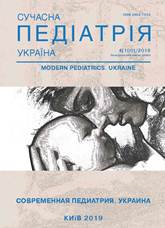Echosonographic investigation of stomach in children with combined gastroesophageal reflux disease and chronic gastroduodenal pathology
Abstract
The high incidence of combined gastroesophageal reflux disease (GERD) and chronic gastroduodenal pathology in children of different age groups necessitates the search for non-invasive research methods that visualize gastroesophageal reflux.
Objective — to compare the results of echosonographic investigations of the stomach in children with combined GERD and chronic gastroduodenal pathologies with endoscopic ones.
Material and methods. 64 children aged from 10 to 18 years with combined GERD and chronic gastroduodenal pathologies were examined. Diagnoses were made basing on the complaints, case histories and objective examination with the help of ICD-10, and verified by upper endoscopy. Echosonographic investigation of the stomach was carried out.
Results. The frequency of revealing gastroesophageal and duodenogastric refluxes did not differ during endoscopic and echosonographic investigations. The frequency of revealing the signs of chronic gastritis during echosonographic investigation was statistically less than that of the same pathology during endoscopic investigation.
Conclusions. Echosonographic investigation of the stomach reveals gastroesophageal and duodenal refluxes with high precision. It can be recommended for using in different age groups of children due to its low invasiveness and can be performed to estimate the effectiveness of correction of motor disorders of the upper divisions of the digestive tract.
The research was carried out in accordance with the principles of the Helsinki Declaration. The study protocol was approved by the Local Ethics Committee (LEC) of institution. The informed consent of the patient was obtained for conducting the studies.
References
Abdullaev RYa, Gapchenko VV, Spuzyak MI, Vinnik YuA. (2009). Ultrasonography of the stomach and duodenum. Kharkov: Nove slovo: 104.
Zagorskiy SE, Kletskiy SK. (2010). Morphological and endoscopic comparisons in the study of the esophagus in children and adolescents. Medical Journal. 3: 75—79.
Zimnytska TV, Shevchenko NV, Holovko TV, Kirianchuk NV, Bulich IM. (2019). Characteristics of the heart rhythm in children with gastroesophageal reflux disease. Child`s health. 14;1: 54—59. https://doi.org/10.22141/2224-0551.14.0.2019.165518
Zubarenko АV, Kravchenko TY. (2013). Modern look to gastroesophagealreflux disease in children. Perinatologiya i pediatriya. 1: 17—19.
Kryuchko TO, Nesina IM. (2013). Features of extraesophageal manifestations of gastroesophageal reflux disease in children. Child`s health. 4: 16—19.
Maev IV, Barkalova EV, Ovsepyan MA, Kucheryavyi YuA, Andreev DN. (2017). Possibilities of pH impedance and high-resolution manometry in managing patients with refractory gastroesophageal reflux disease. Therapeutic archive. 89 (2): 76—78. https://doi.org/10.17116/terarkh201789276-83
Oparin OA, Lavrova NV, Lobunets OO. (2009). The role of ultrasound scanning in diagnostics of gastroesophageal reflux disease in students. Actual problems of modern medicine: Bulletin of Ukrainian Medical Stomatological Academy. 9(4): 161—162.
Tsvetkov PM, Gureev AN, Tsvetkova LN, Kvirkveliya MA, Faustova EV. (2008). Daily pH monitoring in the diagnosis of diseases of the upper digestive tract in children. Pediatria. Journal named after GN Speransky. 67(6): 61—65.
Shadrin OG. (2009). Pediatric aspects of gastroesophageal reflux disease. Health of Ukraine. 6/1: 11.
Carvalho CF, Santos TCRS, Santos AAS, Meirelles MAVFO, Bersot CAC. (2012). Transabdominal ultrasound in the detection of gastroesophageal reflux disease in children: review of 500 cases. ECR 2012. C41857. doi: 10.1594/ecr2012/C41857 https://posterng.netkey.at/esr/viewing/index.php?module=viewing_poster&task=&pi=112608
Dehdashti H, Dehdashtian M, Rahim F, Payvasteh M. (2011). Sonographic measurement of abdominal esophageal length as a diagnostic tool in gastroesophageal reflux disease in infants. Saudi journal of gastroenterology: official journal of the Saudi Gastroenterology Association. 17(1): 53—57. https://doi.org/10.4103/1319-3767.74483; PMid:21196654 PMCid:PMC3099082
Madi-Szabo L, Kocsis G. (2000). Examination of gastroesophageal reflux by transabdominal ultrasound: Can a slow, trickling form of reflux be responsible for reflux esophagitis? Canadian Journal of Gastroenterology. 14(7): 588—592. https://doi.org/10.1155/2000/690605; PMid:10978945
Rosen R, Vandenplas Y, Singendonk M, Cabana M et al. (2018). Pediatric Gastroesophageal Reflux Clinical Practice Guidelines: Joint Recommendations of the North American Society for Pediatric Gastroenterology, Hepatology, and Nutrition and the European Society for Pediatric Gastroenterology, Hepatology, and Nutrition. Journal of pediatric gastroenterology and nutrition. 66(3): 516—554. https://doi.org/10.1097/MPG.0000000000001889; PMid:29470322 PMCid:PMC5958910
Downloads
Issue
Section
License
The policy of the Journal “MODERN PEDIATRICS. UKRAINE” is compatible with the vast majority of funders' of open access and self-archiving policies. The journal provides immediate open access route being convinced that everyone – not only scientists - can benefit from research results, and publishes articles exclusively under open access distribution, with a Creative Commons Attribution-Noncommercial 4.0 international license (СС BY-NC).
Authors transfer the copyright to the Journal “MODERN PEDIATRICS. UKRAINE” when the manuscript is accepted for publication. Authors declare that this manuscript has not been published nor is under simultaneous consideration for publication elsewhere. After publication, the articles become freely available on-line to the public.
Readers have the right to use, distribute, and reproduce articles in any medium, provided the articles and the journal are properly cited.
The use of published materials for commercial purposes is strongly prohibited.

